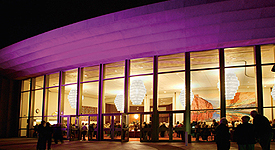
It was 120 years ago this month that Wilbur and Orville Wright made history briefly flying across the sands of Kitty Hawk, North Carolina. Twenty-five years later, the town of Chandler joined the aviation revolution when it established its first airport on a small strip of land a couple of miles southwest of the downtown square.
According to the Chandler Museum, visionary town founder Dr. A.J. Chandler and other community leaders recognized the economic potential and prestige that air travel could bring to the fledgling desert community and they championed the construction of the airfield in the area southeast of Willis and Alma School roads. The dedication ceremony on March 13, 1928, featured Governor George W. P. Hunt and many other VIPs. It was attended by more than 2,500 people and drew international attention to what many pilots considered one of the finest airfields in the southwest.
The town was now literally on the map (airway maps) and attracting more visitors from across the nation. Then, two notable events occurred, including one that significantly deferred the aviation dreams of the community. First, for safety and other reasons, the airport was relocated one year later to a spot where Tumbleweed Park is today. Second, the 1929 stock market crash and subsequent Great Depression brought airport operations and plans for growth to a near standstill for many years.
It wasn’t until after World War II that the town of Chandler recommitted to the goal of being home to a top-tier community airport. A small private airfield east of the old airport was identified as the prime location for the new enterprise. In 1948, the town obtained the deed for the new Chandler Airport and begin building the site into the outstanding facility it is today.
“The airport’s history and growth mirror the development and progress of the city itself,” said Airport Manager Ryan Reeves, who has overseen airport operations in Chandler for more than four years. “We're approaching a century of aviation in Chandler, and we are in our 75th year of aviation at this location, and that's a milestone any airport needs to celebrate.”
That community, Chandler Airport Day, celebration will be on Saturday, Jan. 20, 2024, from 8 a.m. to 2 p.m. There is no charge for event admission or parking, several food trucks will be on site offering food and beverages for sale, plus there will be information and activity booths and, of course, aircraft displays.
There will be static displays of a wide variety of aircraft that make Chandler Municipal Airport their home and others that will fly in from airfields across the southwest. “We will showcase every era of flight, from the days of biplanes to rotary aircraft to modern executive jets and everything in between,” Reeves says. “There will be old military planes, fixed-wing aerobatic planes, and a collection of experimental aircraft that were built here and took their first flights here. Yeah, it’s going to be a heck of a show.”
Reeves is also hoping to provide opportunities for guests to take rides in some aircraft during the event. In addition, the Chandler Fire and Police departments will have information booths and vehicle displays at Airport Day, and Reeves emphasized his appreciation for the support the airport has received through the years from the two departments and many others.
“The airport depends on partnerships within the community to operate safely and effectively,” Reeves said. “When you see an airplane or a helicopter flying overhead you may think, ‘Oh, there's one or two people up there.’ But you don’t see the three or five or many more people on the ground who helped make that flight possible. They are the mechanics, refueling crew, air traffic controllers, facility maintenance and operations staff, and others who keep all the pieces moving.” All of those moving pieces are also integral parts of the vast economic engine powered by airport operations.
Reeves emphasizes that it would be a mistake for anyone to think of Chandler Municipal Airport as just a little community airport; that it is, in fact, the 50th busiest airport in the entire nation, part of a network of more than 5,000+ airports that are integral to aviation in North America. The 550-acre facility is home base for more than 450 aircraft of 180 different types.
“We’re inviting everyone in the community to come out and see what we do here at the airport and how our work affects their lives,” Reeves said. Because by the nature of how airports are designed and secured they can often look imposing and inaccessible. “We joke that they look like reverse prisons because of all the fences and barbed wire. They are an alien world to 99% of the population. And on Airport Day we can bring everybody in through the gates and say, ‘Look how amazing this is!’”
That ‘other’ airport that helped Chandler grow and flourishFor many decades, Chandler was best known in the worldwide aviation community as the home of an airfield that wasn’t even in the town and city borders. In July 1941, construction began on a new United States Army Air Corps flight training base eight miles east of downtown Chandler. The new base opened in December, just prior to the Japanese attack on Pearl Harbor and America’s entry into the Second World War. According to the Chandler Museum: The base initially went through various names, including Mesa Military Airport and Higley Field before it was officially dedicated as Williams Field in February 1942. It was named for 1st Lt. Charles Linton Williams, an Arizona native who died in 1927 when his aircraft crashed near Fort DeRussy in Hawaii. “Willie,” as the base was affectionately called, sat on land that is now part of Mesa. But when it opened, and all throughout its history, it was always tied closely to Chandler. This was most likely because Chandler was the nearest town of a substantial size. Higley and Gilbert were little more than crossroads, and Mesa was several miles north and west of the base. Printed material produced at the base read “Williams Air Force Base, Chandler, Arizona.” The base had an immense impact on Chandler. Officers found housing for their wives in Chandler, and the base did all of its banking and payroll through the Valley National Bank branch in Downtown Chandler. Enlisted men spent their free time and money in Chandler, and countless residents opened spare rooms and rented out buildings to military wives and families. Whereas many of the training facilities that sprung up during the war closed after 1945, Willie remained open and was converted to a jet training school. A lot of veterans returned to Chandler to live after their discharge from the service. Over the years, thousands of civilians from Chandler were employed at Willie, doing everything from painting aircraft to operating the base phone system and everything in between. The base remained an important training facility for the Air Force until 1993, when it was closed on August 30. Since then, the base has been converted to Phoenix-Mesa Gateway Airport and is the home to ASU Polytechnic and CGCC-Williams Campus. |
This blog post also appeared in the SanTan Sun News: Dec. 31, 2023 edition.



